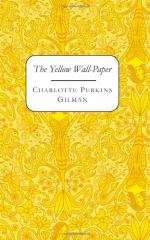|
This section contains 8,128 words (approx. 28 pages at 300 words per page) |

|
SOURCE: Treichler, Paula A. “Escaping the Sentence: Diagnosis and Discourse in ‘The Yellow Wallpaper.’” Tulsa Studies in Women's Literature 3, no. 1-2 (spring/fall 1984): 61-77.
In the following essay, Treichler asserts that the underlying narrative of “The Yellow Wallpaper” involves the narrator's confrontation with language, by which she defies patriarchal control and male judgment.
Almost immediately in Charlotte Perkins Gilman's story “The Yellow Wallpaper,” the female narrator tells us she is “sick.” Her husband, “a physician of high standing,” has diagnosed her as having a “temporary nervous depression—a slight hysterical tendency.”1 Yet her journal—in whose words the story unfolds—records her own resistance to this diagnosis and, tentatively, her suspicion that the medical treatment it dictates—treatment that confines her to a room in an isolated country estate will not cure her. She suggests that the diagnosis itself, by undermining her own conviction that her “condition” is...
|
This section contains 8,128 words (approx. 28 pages at 300 words per page) |

|


